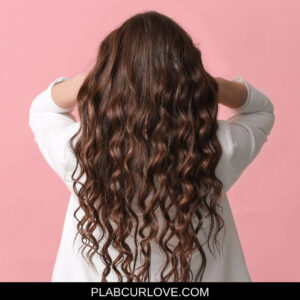Blog
How to Prevent Frizz: Wavy Hair

Does your wavy hair have a mind of its own? Frizz can be the unruly kink in an otherwise perfect wave, and for the wavy hair community, it’s a daily struggle. Fear not, fellow wavies, for this listicle is your roadmap to frizz-free waves using natural, plant-based solutions. Whether it’s understanding the nature of your hair or the power of plant-derived products, we’ve got you covered from shower to waves. Read on about how to prevent frizz in wavy hair.
Why Does My Hair Frizz Up?
Understanding the cause is the first step to prevention. Frizz is often the result of lack of moisture, or conversely, excessive humidity. It can also be a sign of damage from heat styling or harsh chemical treatments. Before you can banish frizz, you need to know your enemy.
Frizz forms when the cuticle layer of your hair is raised, allowing moisture to pass through and swell the strands. But it’s not just two-dimensional hair that frizzes; wavy hair’s irregular patterns can magnify frizz, especially when curls start to separate or lose their shape.
What Can Cause Wavy Hair to Frizz?
Waves can be particularly prone to frizz because they’re less uniform than straight hair. It’s easier for curls to tangle and rub together, creating more ‘friction’ that can result in flyaways. Common culprits include:
- Over-washing with harsh shampoos
- Not conditioning enough (or conditioning too much)
- Rubbing hair dry with a towel
- Sleeping on a cotton pillowcase
- Overuse of heat styling tools
- Using products with drying alcohols or silicones
10 Natural Ways to Tame the Frizz
Now for the good stuff — how to wrestle that frizz under control. The following tips are recommended for those who want to avoid the chemical cocktail that often comes with commercial hair products.
1. Understand Your Hair’s Needs
The best way to prevent frizz is to meet your hair’s needs. Start by decoding your hair type — wavy hair can range from S-shaped to almost-curls which have different needs. Understanding if your hair is fine, coarse, low-porosity, or high-porosity directs your product choices.
2. Gentle, Plant-Based Cleansers
Say no to sulfates! They’re effective cleaners, but they’re too good at their job, stripping hair of its natural moisture. Opt for plant-based shampoos that are gentle on the scalp and hair, and always follow up with a conditioner. Look for ingredients like coconut oil, aloe vera, and essential oils.
3. The Cold Rinse
After conditioning, end your shower with a blast of cold water. The cold seals the cuticle, reducing the chance of frizz. It’s a quick and easy step that can make a big difference.
4. Plopping Your Hair
Plopping is a drying technique where you use a T-shirt or microfiber towel to wrap your wet hair on top of your head. This helps your hair dry in a more defined, less chaotic manner, which can result in less frizz.
5. No More Towel Turbans
Traditional terrycloth towels are like velcro for wavy hair — they rough up the cuticle and encourage tangles and frizz. Consider swapping to a microfiber towel for a gentler drying experience.
6. Detangle with Care
Comb your hair with a wide-toothed comb when it’s wet, ideally when you’ve just conditioned it. This ensures tangles and knots don’t lead to hair breakage, which can also cause frizz.
7. The Magic of Oils
Natural oils can be your best friend against frizz. Look for argan, jojoba, sweet almond, or coconut oil. You can apply them to damp hair and they will lock in moisture and combat frizz without weighing your waves down.
8. Weekly Deep Conditioning
Deep conditioning treats your hair to an intensive moisture boost. DIY an avocado or banana mask, or invest in a plant-based deep conditioner. Your hair will thank you with added luster and softness, and a reduced likelihood of frizz.
9. Style Without the Fuzz
If you’re going to style your hair, use a heat protectant and opt for the lowest effective temperature. The less heat from styling tools, the better for your hair’s health and frizz prevention.
10. Beware the ‘Frizz’ Ingredients
Silicones make hair temporarily appear shiny and smooth, but they can cause build-up and dryness in the long run. Avoid products with ingredients that end in ‘-cone’ — cyclomethicone, dimethicone, and any other ‘xanes or ‘conols.
By incorporating these natural, holistic approaches into your hair care routine, your wavy locks are sure to become more manageable, frizz-free, and healthier over time. The transition may require some patience, but the dividends in terms of hair health and environmental friendliness are well worth it.
Be patient with your hair as you try these tips. It can take time for your hair to adjust to new products and routines. Don’t give up if you don’t see immediate results — sometimes the best changes are the ones that happen over time.
Ultimate Curly Hair Guide!

Transform your curls today with the ultimate guide to perfect curls—get your copy now! 🌀📚✨
Buy Now